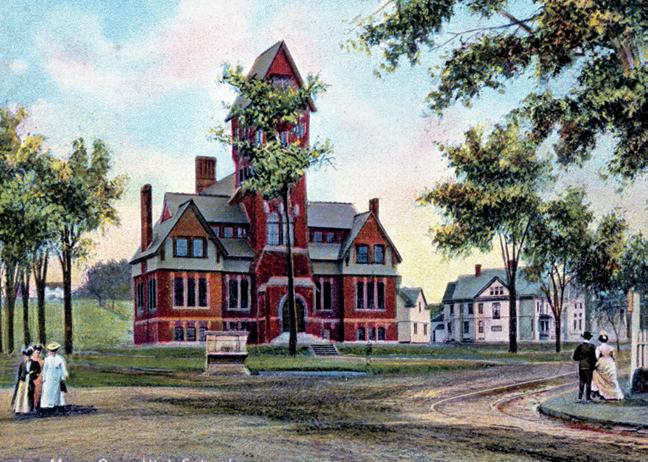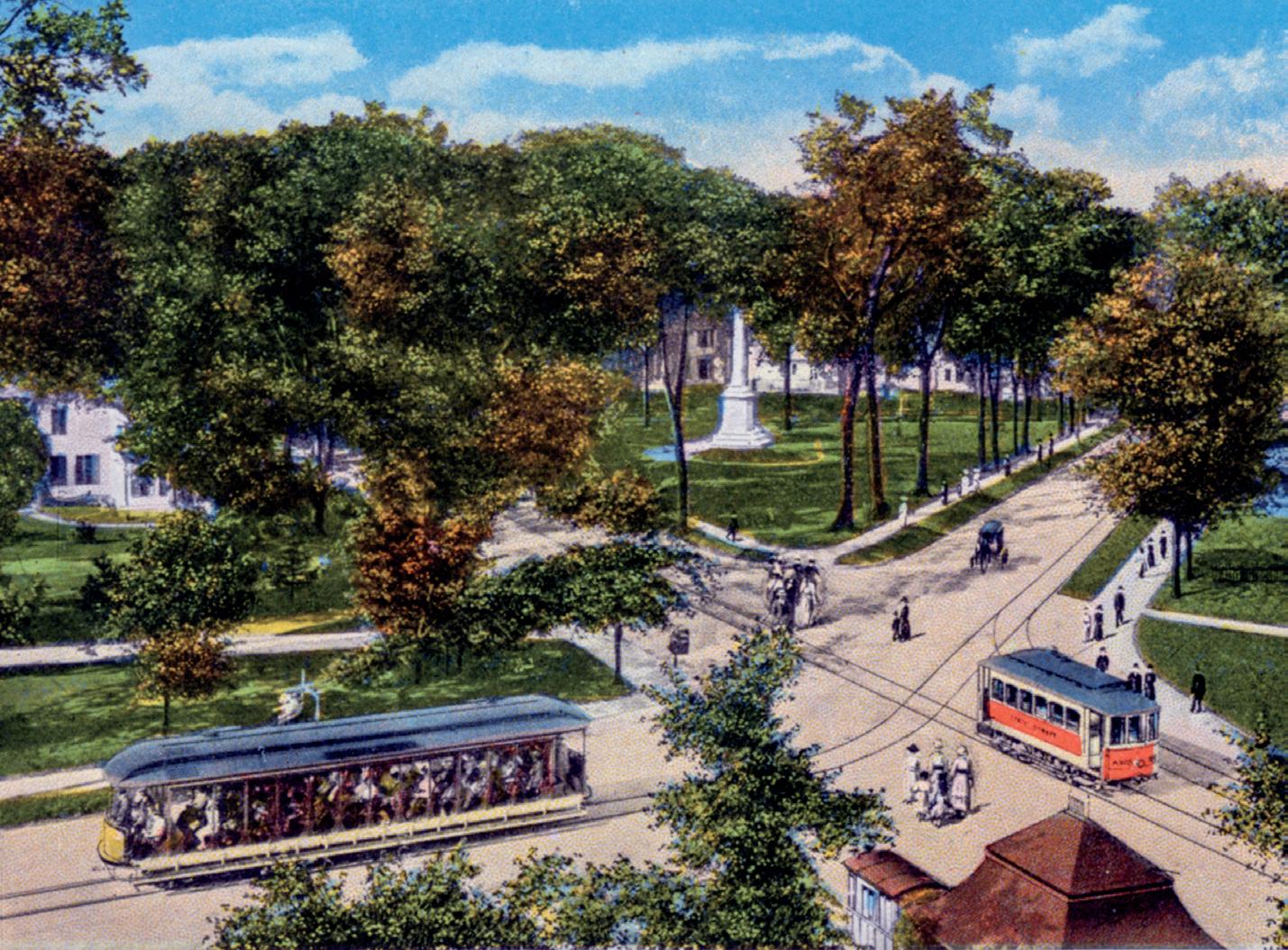
6 minute read
IV. A Brief History of Augusta
A Brief History of Augusta
e Founding
Advertisement
Augusta, where our Bank was founded in 1870 and is still headquartered today, dates from the early 17th century by the Plymouth Colony, a group of Puritan Separatists who came to be known as the Pilgrims. ey established a trading post on the Kennebec River at a site known by its Native American name— Cushnoc (or Coussinoc or Koussinoc), meaning “head of the tide.”
Later, in 1754, Fort Western was constructed in Augusta and Fort Halifax was constructed in Winslow. In 1762, the rst lots were granted to encourage settlement around the fort. e resulting village was comprised of seven huts occupied by 30 residents. Later, in 1769, Captain James Howard bought 900 acres, including the fort, and constructed a sawmill, the rst industry in the area.
In 1788, the rst bridge was built over Bond Brook, but a heavy rain swept the bridge away that next year. Work on Augusta’s rst courthouse began in 1790 in Market Square, and the Eastern Star—Augusta’s rst newspaper—went into circulation four years later.
In 1797, the Kennebec Bridge was built, de ning Augusta as a city that occupied both sides of the river.
Opposite: School day over, these Cony High School girls head for home over the Iron Bridge, built in 1890. In the background is the then new Augusta City Hall, built in 1896.
Right: Fort Western, once the commercial and political center of early Augusta, is shown here in 1885 as a tenement; it remained so until its restoration by W.H. Gannett in the 1920s.

A Center for Industry
By the 1800s, Augusta was known as a great publishing center and manufacturing center for cotton, wool and paper. Between 1802 and 1864, 60 coastal vessels and deep-water ships were built on the shores of the Kennebec.
e hub of activity during those days was Water Street. e rst brick stores were erected here in 1806. It was soon lined with a mix of retail shops, hotels, banks, the post o ce, publishing houses, sawmills, horse stables and an opera house, which would become one of Kennebec Savings Bank’s early locations.
Also in 1806, the rst stagecoach to Augusta began providing twice weekly service between the town and Brunswick. 1808 marked the rst year granite was quarried in Augusta.
Also in 1808, a disturbance called the Malta War started over disputed land titles. As a result, the jail was burned, and an attempt was made to burn the courthouse. e event culminated with a trial and acquittal of seven people accused of murdering a surveyor, Paul Chadwick.
In 1814, the town and its people fell on hard times as the War of 1812 was making it di cult to make an income and, as a result, generate tax revenue. In 1815, the War of 1812 ended, reviving trade. at same year, Cony Female Academy was founded.
e Kennebec River Bridge collapsed in 1816, and it would be two years before it was rebuilt. e new bridge was a covered bridge, the rst of its kind in the area.
In 1820, Maine separated from Massachusetts and gained statehood. Augusta would be named the state capitol in 1832.
e Kennebec Journal began publishing as a weekly newspaper ve years after Maine became a state. Now a daily newspaper, it is still the primary local news source for the people of Augusta.

This Queen Anne style building served as Augusta’s high school until replaced by the flatiron building in the 1920s. It was replaced again by a new Cony High School further to the west in 2016.
Opposite: Augusta’s Monument Park c. 1905. The park was conveyed to the city in 1879 and the Civil War monument to Augusta’s Civil War dead was dedicated in 1882. Kennebec Savings Bank later moved to this neighborhood—its present location.


e Kennebec River
e ability to harness the Kennebec for power further strengthened the local manufacturing industry. In 1834, the Kennebec Dam Company was chartered and, in 1846, construction of a 10,000-spindle cotton mill at the dam site was completed. It later became Bates Manufacturing, famous for manufacturing eld jackets and shoe linings during World War II.
e Kennebec River was the preferred mode of transporting freight to Portland and Boston via steam ships. e rst regular steamboat service between Kennebec ports and Boston started in 1836. e rst Kennebec Dam was constructed in 1837, completed at a cost of $600,000. In 1843, six sawmills and a large our mill were erected. Seven people died in May 1848 when the steamer Halifax blew up in the Kennebec Dam lock.
In 1855, a ood swept away 100 feet of the dam. In 1870, 160 feet of the dam was swept away. Transportation began to evolve in the mid 1800s. e rst locomotive reached Augusta in 1852, several years after it received its city charter in 1849. Augusta’s rst depot was constructed soon after but was destroyed by re, along with 12 freight cars, in 1864. e railroad line was extended bit by bit, and Augusta was soon providing service between Bangor and Boston.
Opposite: The last day of the Della Collins is captured in this 1905 photograph. From 1879 to 1905, the Della Collins carried passengers and freight between Augusta and Bath. The Della Collins was broken up in 1906.
Right: Circa 1910 view of passengers boarding the Augusta-Winthrop and Gardiner Street Railway trolley bound for Winthrop.

e Civil War
Maine soldiers served proudly in the Civil War. In 1861, when war was declared, Augusta raised two companies in 24 hours. Augusta also served as the mobilization point for Kennebec Valley troops on the way to battle.
By 1866, a home for Civil War veterans was established at Togus. Today, it is the oldest veteran-related facility in the country.
General Joshua L. Chamberlain, who would later become the Governor of Maine, was instrumental in ending the war. It was he who accepted the surrender of General Robert E. Lee in Virginia.



e Great Fire
Fire occurred often in Augusta but, by all accounts, the re of 1865 was the worst. Most of the buildings at that time were constructed of wood. e re, driven by wind, spread quickly. All but four buildings between Bridge and Winthrop Streets were destroyed, causing a half-million dollars’ worth of damage.
It is said that the re was started by a disgruntled lobsterman from China who was angry about how the local police had handled the theft of his lobsters by some locally stationed soldiers.
e town was quick to recover. e rst bank to be rebuilt was Freeman’s National Bank, which later became the rst home of Kennebec Savings Bank.
Left: An engraving of the National Asylum for Disabled Volunteer Soldiers, Eastern Branch of Togus, as it appeared in The Maine Farmer, August 1870.
Opposite: The Commercial Street railroad station is the location of this photograph of the Maine National Guard leaving for the SpanishAmerican War in 1898. Photo Credit: Kennebec Historical Society, photograph gift of Mr. & Mrs. Raymond Leclair.











